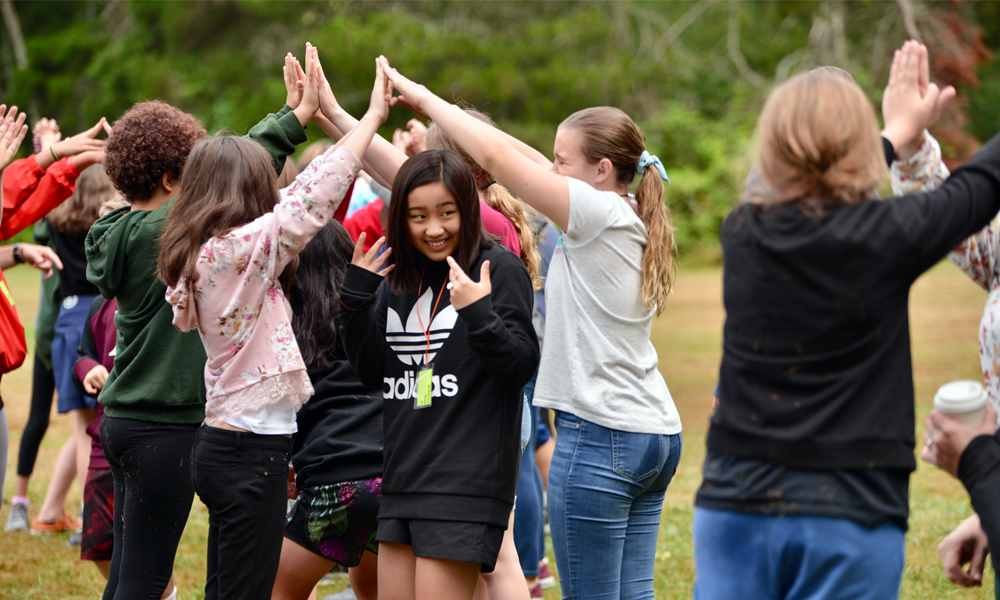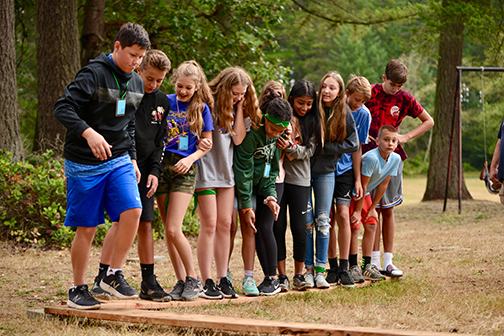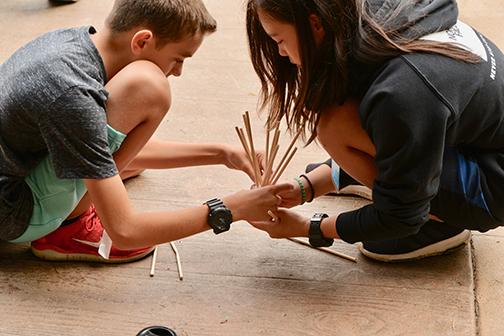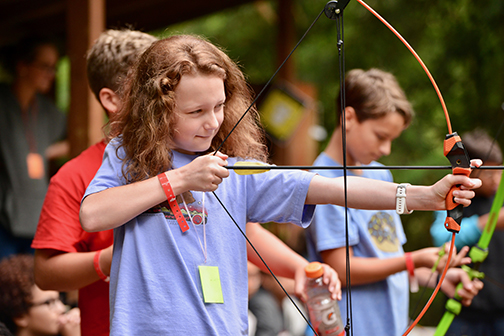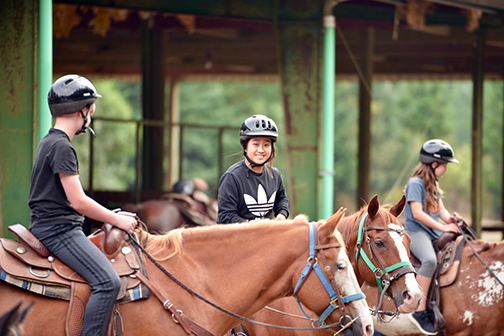Middle School Camp and Community Building
By Joanna Manning
On the porch of the Wild West styled trading post at Miracle Ranch, a few students are playing shuffleboard. Others have assembled a pick-up game of basketball, which has attracted spectators, and they joke with the players from the sidelines. A trio of friends has sprawled out in the grass together, chatting idly as they watch wisps of clouds drift through the late-summer sky. Soon they will be called together for formal activities—timeless camp staples of horseback riding, archery, and canoeing among them—but for now, they simply enjoy the unscheduled time together.
Middle school camp is a long-standing Charles Wright tradition. Each year, students begin the school year by spending two days at Miracle Ranch in Port Orchard, giving returning students an opportunity to reconnect after the summer and new students the chance to make friends and get acquainted with their teachers. Though brief, this time together is integral to building a strong sense of connection and community.
“We begin camp at their meeting space in the cedars with an intentional focus on the Charles Wright values of integrity, respect, compassion, perseverance, and excellence.” Director of Middle School Bill Schuver said, “Different faculty members describe what each means to them and how it can be viewed in the Middle School. We designed activities where grade level teams could have students reflect on each of these values throughout the entire camp.
Students also work with English teacher and Diversity, Equity, and Inclusion Coordinator Rob Scotlan to develop behavior norms for the year and identify what they need in order to have a comfortable and productive learning space. Answers range from (8th-graders’) requests for comfy chairs and snacks to more earnest desires for mutual trust between students and teachers.
Around the camp, mutual trust and affinity between teachers and students is already obvious, even among the new students. During a break between activities, a gang of sixth graders takes turns speculating about how art teacher Tom Hughes broke his arm.
“I think he was fighting aliens!” one student yells out, eliciting giggles from the rest of the group. “Maybe it was a car accident?” another suggests.
Mr. Hughes leans into their game, providing a few outrageous suggestions of his own, to the students’ delight. As the group walks off to their next activity, one girl, new to the school this year, sighs, “This is so much fun.”
Students are not alone in forging bonds at camp. The experience is valuable for the faculty as well and helps to set the tone for the academic year.
“Being at camp probably buys us about a month of relationship building,” Ms. Rippl said. “I know every student’s name by the end of camp. I even have a sense of how they interact in playful spaces and in more structured activities. It’s so helpful to see how they relate to one another and how we can help nudge kids in certain directions to form relationships.”
During team building games, relationships are forming easily in some corners and being stressed in others. One ebullient group of sixth-grade students falls on the ground into a laughing heap in a game of “human knot” gone awry. Meanwhile, an eighth-grade team struggles to communicate during an engineering challenge, and their frustration mounts as they try to agree on a solution to their problem. They persist. And succeed.
The social-emotional learning that is inherent to the camp experience provides some of the most lasting benefits to campers. A recent study of 1,300 students entering middle school illustrated that social-emotional learning had measurable effects on student success: Students who were simply told to expect challenges and that they would be supported in their efforts to overcome those challenges had fewer disciplinary problems, better attendance, and better academic performance.
At camp, students are expected to navigate various challenges, knowing that they have the support and guidance of their teachers if needed. They have to cooperate and solve problems. They are often challenged to push themselves out of their comfort zones. At the horse stables, one girl flashes a look that is equal parts excitement and terror as the wrangler checks her saddle before they head off onto the trail. She is all smiles by the end of the ride, the confidence she gained by persisting through her initial discomfort visible in her demeanor. She will carry this confidence back to the classroom with her.
When the students return to school, they will find one of their first camp projects—the “I am” portrait—on display. As an icebreaker activity, students had selected a word that best describes them. The collection of words will be patched together to form a quilt that will hang in the halls of the middle school. French teacher Maren Hassenger describes the power of that simple project: “When they look at this wall, they will see pieces of themselves, and those pieces are not what they wrote down,” she said. “And they recognize that many other people have things in common with them.”
Ms. Rippl has been participating in middle-school camp for years, and her enthusiasm for the experience has never waned. “Although it’s a huge energy output on the outfront, there are so many benefits of coming to camp and having the kids feel more connected, especially for the new students,” she said. “Some students have barely set foot on campus, and they are walking away with three or four new friends. That makes a huge difference.”

